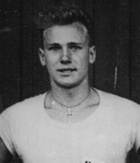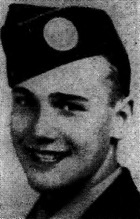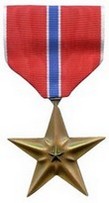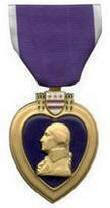Walt Lupton
| Date and Place of Birth: | 1924 Springfield Gardens, Queens, NY |
| Date and Place of Death: | September 18, 1944 Wylerbaan, Holland |
| Baseball Experience: | Amateur |
| Position: | Catcher |
| Rank: | Corporal |
| Military Unit: | Machine Gun Platoon, 2nd Battalion, HQ Company, 508th Parachute Infantry Regiment, 82nd Airborne Division |
| Area Served: | European Theater of Operations |
Walter R. Lupton, the son of Mr. and Mrs. Charles W. Lupton, was born
in 1924 in Springfield Gardens, a middle-class neighbourhood in Queens,
New York. He attended Andrew Jackson High School where he excelled in
baseball as a catcher and basketball as a forward.
Lupton played baseball in the Queens Alliance for Cambria Baseball Club
and featured on numerous local basketball teams including the
Springfield Gardens Squadron of the Sons of the Legion, the Springfield
Rams and the Springfield Pioneers.
Aged 18, Lupton entered military service with the Army on October 30,
1942, and promptly volunteered for the paratroopers. Assigned to the
508th Parachute Infantry Regiment, Private Lupton was stationed at Camp
Mackall in North Carolina during the summer of 1943, where he played for
the 508th Red Devils baseball team. The team, with minor league pitcher
Lefty Brewer, dominating the opposition, had a 26–4 won-loss record that
year, and clinched the Camp Mackall championship by defeating the 135th
Quartermaster Company in the league playoffs.
On December 20, 1943, the 508th PIR moved to Camp Shanks, New York, in
preparation for overseas deployment. The men were given passes for two
nights in New York over Christmas and were then loaded onto the USAT
James Parker on December 27. They arrived in Belfast, Northern Ireland,
on January 8, 1944, and camped in the small town of Port Stewart. The
regiment was attached to the 82nd “All American” Airborne Division and
participated in night training maneuvers while waiting for the
inevitable invasion of mainland Europe.
In March 1944, the 508th PIR left Northern Ireland for Scotland, then
traveled by rail to Nottingham, England. On Sunday, May 28, 1944, the
508th Red Devils baseball team unexpectedly reformed for their final
game before going into combat. Speculation still hangs over the reason
this game was staged. The “official” story at the time was that the
Nottingham Anglo-American Committee requested the Americans to stage a
sporting event because the people of Nottingham had for years been void
of entertainment. However, because the game was arranged by Brigadier
General James M. “Jumpin’ Jim” Gavin, commander of the 82nd Airborne
Division, many believe the game was designed to fool the Germans. If
American paratroopers were playing baseball in England, how could an
invasion be imminent?
May 28, 1944, was a beautiful day and an enthusiastic crowd of 7,000
fans gathered beneath clear blue skies at Meadow Lane soccer ground to
see the 508th Red Devils play the 505th PIR Panthers. A photograph of
the Red Devils shows how unprepared they were for the game. Wearing jump
boots, combat fatigues and vests, the ballplayers have an almost
bewildered look on their faces as they pose for the camera, each man
wearing a number pinned to his vest for easy identification when the
photos were sent back to their hometown newspapers. Nevertheless, the
game was a great success and the Red Devils outclassed the Panthers,
18–0.
Just days later, Lupton, now a corporal, made his first combat jump into
France on D-Day, June 6, 1944. Four of his teammates, including minor
league pitcher Lefty Brewer lost their lives in Normandy. Lupton
survived Normandy and made a further jump at Nijmegan, Holland
(Operation Market Garden) on September 17, 1944. He was fatally wounded
on September 18 at Wylerbaan Drop Zone and died later that day. Corporal
Lupton, who is buried at the Margraten American Cemetery in Holland, was
awarded the Bronze Star and Purple Heart.
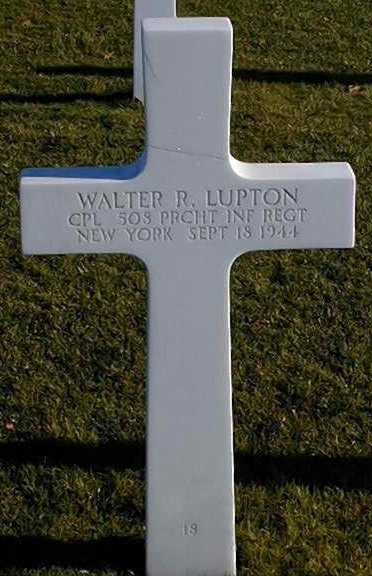
Sources
Long Island Daily Press, January 28, 1938
Long Island Daily Press, December 28, 1939
Long Island Daily Press, February 7, 1940
Long Island Daily Press, February 27, 1940
Long Island Daily Press, September 12, 1940
Long Island Daily Press, November 21, 1940
Long Island Star Journal, May 21, 1941
Long Island Daily Press, February 12, 1942
Long Island Daily Press, April 13, 1942
Long Island Daily Press, December 18, 1944
Date Added July 5, 2013
Can you add more information to this biography and help make it the best online resourse for this player? Contact us by email
Read Baseball's Greatest Sacrifice Through The Years - an online year-by-year account of military related deaths of ballplayers
Baseball's Greatest Sacrifice is associated with Baseball Almanac
Baseball's Greatest Sacrifice is proud to be sponsored by

